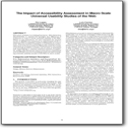论文成果 / Publications
2010
pPen: enabling authenticated pen and touch interaction on tabletop surfaces
Abstract
This paper introduced pPen, a pressure-sensitive digital pen enabled precise pressure and touch input on vision based interactive tabletops. With the help of pPen inputs and feature matching technology, we implemented a novel method supporting multi-user authenticated interaction in the bimanual pen and touch scenario: login can be performed just by stroking one's signature with pPen on the table; a binding between user and pPen was created at the same time, then each interaction command made by pPen is user differentiating. We also conducted laboratory user studies, which later proved the safety and the high resistance to shoulder surfing problem: in the evaluation procedure, any attacker can never log into other user's working space.
A tabletop multi-touch Dali's painting appreciation system
Abstract
Painting artworks, especially those having surreal or super-rational elements, are difficult for ordinary people to deeply appreciate in a static exhibiting manner. We believe that bringing interactivity to an existing painting would have benefits of emphasizing the theme, encouraging active and collaborative learning, and compensating its aura. To this end, in this paper we present DALI (Dali's Artwork for Learning Interactively), a multi-touch system designed to guide viewers in their processes of appreciating painting artworks. The current system runs on a multi-touch tabletop. 30 paintings of Spanish artist Salvador Dali's were digitized, deconstructed, and interactively displayed on the table. Visual effects on the paintings can be triggered by hand and finger gestures-an effective way of visual arts education.
iWebImage: Enabling real-time interactive access to web images
Abstract
Images are widely used in web pages. However, most web images can only be viewed passively. Currently, it remains inconvenient for users to collect and save web images for further editing. The positioning of a certain image in web pages with a large number of images, such as the image search results, is also troublesome and time-wasting, especially for mobile devices with small screens. In this paper, we propose to enable real-time interactive access to web images and design three modes of browsing web images including normal mode, starred mode and advanced mode. We implement a plug-in for Microsoft Internet Explorer, called iWeblmage, which incorporates efficient computer graphics algorithms and provides a customized user interface supporting real-time interactive access to web images. Experimental results show the usage scenarios of the three browsing modes and prove that iWeblmage is well accepted by users.
Enhancing browsing experience of table and image elements in web pages
Abstract
As the popularity and diversification of both Internet and its access devices, users' browsing experience of web pages is in great need of improvement. Traditional browsing mode of web elements such as table and image is passive, which limits users' browsing efficiency of web pages. In this paper, we propose to enhance browsing experience of table and image elements in web pages by enabling real-time interactive access to web tables and images. We design new browsing modes that help users improve their browsing efficiency including operation mode, record mode for web tables and normal mode, starred mode, advanced mode for web images. We design and implement a plug-in for Microsoft Internet Explorer, called iWebWidget, which provides a customized user interface supporting real-time interactive access to web tables and images. Besides, we carry out a user study to testify the usefulness of iWebWidget. Experimental results show that users are satisfied and really enjoy the new browsing modes for both web tables and images.
A Policy-Driven Service Composition Method for Adaptation in Pervasive Computing Environment
Abstract
Service composition allows distributed application, such as multimedia application, to be composed from atomic service units and to adapt dynamically to users' requirements and environment conditions in pervasive computing system. It augments the adaptation action space for the application of pervasive computing. According to the multidimensional QoS (Quality of Service) requirement of pervasive computing system, we proposed a comprehensive service composition method to enhance the capability of application adaptation. First, according to a hierarchy policy model and a policy specification language, strengthened by event calculus, service discovery policy action integrating the situation of user, application, environment and resource can be triggered. Secondly, the proposed physical space model can support the location-aware service discovery and explicit range query to improve the efficiency of the query. To the end, an adaptation policy evaluation model is utilized to maximize an evaluation criterion–quality of satisfaction of users and environment by optimizing the optional service selection and the composition path. Through experiment and discussion of the algorithm, the paper further illustrates the great potential advantage of the solution to service composition.
